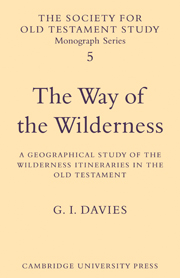Book contents
- Frontmatter
- Contents
- Preface
- Abbreviations
- Maps
- 1 Introduction
- 2 Jewish interpretations in Greek
- 3 Jewish interpretations in Hebrew and Aramaic
- 4 Christian interpretations
- 5 Arabic interpretations
- 6 Behind the traditions
- 7 Key points on the routes
- 8 Routes in the Sinai Peninsula
- 9 Identification of the routes described
- Notes to the text
- Bibliography and Author Index
- Indexes
8 - Routes in the Sinai Peninsula
Published online by Cambridge University Press: 04 August 2010
- Frontmatter
- Contents
- Preface
- Abbreviations
- Maps
- 1 Introduction
- 2 Jewish interpretations in Greek
- 3 Jewish interpretations in Hebrew and Aramaic
- 4 Christian interpretations
- 5 Arabic interpretations
- 6 Behind the traditions
- 7 Key points on the routes
- 8 Routes in the Sinai Peninsula
- 9 Identification of the routes described
- Notes to the text
- Bibliography and Author Index
- Indexes
Summary
The location of Mount Sinai in the south of the Sinai peninsula and of Kadesh at or near Ain Qadeis, together with the identification of ‘Yarn Suf’ as the Hebrew name for the Gulfs of Akaba and Suez, defines the general area to which the wilderness itineraries refer as the Sinai peninsula. Before passing to the detailed identification of the routes described it will be useful to take note of roads linking the points already identified which have been found practicable in the Biblical period and since. In the Sinai peninsula, as in other difficult terrain, it is not possible to travel by just any route: the physical features, particularly the mountain areas and the escarpments, prescribe certain routes from which all travellers have been bound to choose. It is probable that when the attempt was made to define the route taken by the Israelites through the desert use was made of descriptions of routes, oral or written, which were already employed by travellers.
Already in the Old Testament several routes are mentioned by name in the peninsula, but there has not been total agreement on their identification. It is even possible that the same route may have had different names, the choice depending on which way one was going. For our present purpose it is not necessary to become involved in this controversy, because the scholars involved do not disagree about what routes were in use but only about the names by which they were known.
- Type
- Chapter
- Information
- The Way of the WildernessA Geographical Study of the Wilderness Itineraries in the Old Testament, pp. 76 - 78Publisher: Cambridge University PressPrint publication year: 1979



